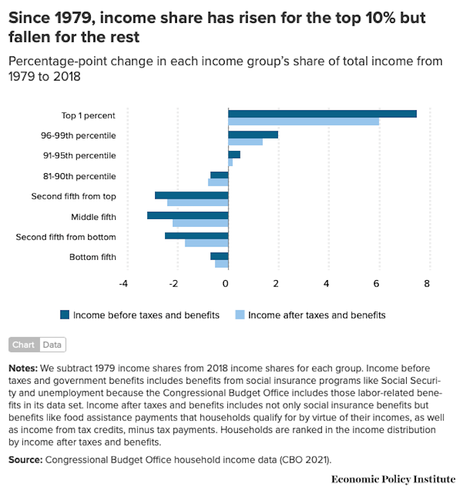
The United States has a vast, and growing, inequality in wealth and income between the rich and the rest of the population. It is now as large as it was right before the Great Depression. Republicans would like you to believe that when the rich do better, everyone benefits (because much of that money trickles down to the rest of the population. But that doesn't work -- it only fattens the bank accounts of the rich, and little to nothing actually trickles down.
But that is not the only problem. This vast inequality is also a drag on the economy -- hurting the nation's economic growth. The Economic Policy Institute has written an excellent article on this, and I recommend you read it. Here is their conclusion:
Since the late 1970s, income inequality has risen sharply enough and been sustained long enough to have significant macroeconomic and fiscal effects. This inequality has led to chronic shortfalls of demand stemming from weakened household spending. These chronic demand shortfalls have constrained economic growth—by as much as 3.4% of GDP per year—and contributed strongly to the very slow recoveries following the most recent three recessions predating the coronavirus recession. The early 1990s recovery was the first one dubbed “jobless,” but employment recovered even more slowly in the early 2000s recovery and the recovery from the Great Recession of 2007–2009 (Bivens 2016).
Even as rising inequality dragged on demand growth and harmed recovery from these three recessions, policy levers meant to help the economy bounce back faster were either becoming less effective (interest rates were near or at zero and couldn’t be lowered further) or were left unused (Congress failed to provide sufficient fiscal stimulus by boosting spending). So far, the recovery from the recession caused by the COVID-19 shock has been happily much more rapid, almost entirely due to the much greater fiscal effort—spending increases—put into recovery. But the fiscal push that aided recovery so far is gone, while almost certainly little progress has been made in lessening inequality. As time marches on, the demand-depressing effect of this higher inequality could start to reassert itself.
In fiscal terms, the key effect of rising inequality has been to redistribute income from the low- and moderate-income households that tend to be net recipients of disposable income from the tax and transfer system toward the higher-income households that tend to be net payers to this system. As income gets transferred from low-savings to high-savings households, where is the increased savings going? A good chunk of it goes to reducing measured budget deficits. As we note in the text box explaining why some measures of aggregate personal savings haven’t risen over recent decades, the reduced budget deficits that accompanied the rise in inequality is in some sense “where” the extra savings one would expect from a rise in inequality have shown up.
There are economic circumstances in which moving closer to federal budget balance might aid economic growth. But the U.S. economy has not enjoyed those circumstances for much of the last four decades. Economic growth has been constrained by weakened demand for sustained periods since 1979, which means that there was no particular economic benefit from lower budget deficits. Essentially, the macroeconomic downside of higher inequality—the drag on economic growth—likely neutralized any fiscal upside.

